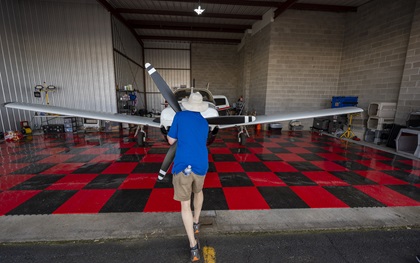Hangars in high demand
Surveys cite scarcity, waiting lists, deposits
Aircraft hangars are in high demand and short supply, with some airports compiling waiting lists that can top several years, according to two surveys, one sent to more than 700 AOPA Airport Support Network volunteers, and the other to all 116 public-use Pennsylvania airports.
The results of the Airport Support Network survey indicated that 71 percent of the airports surveyed have a waiting list for their hangars, and at those airports with a waiting list, 72 percent of aircraft owners waited from six months to more than two years. When the wait is over, the available hangar may not be in the desired condition. Only 8 percent of hangars were described as in “excellent” condition, while 36 percent were described as in need of “some” or “major” repair.
Beechcraft Bonanza A36 owner Bryan Eastman of Atlanta said the airport initiated a new hangar waiting list about three years ago with a more substantial deposit that “weeded out” some of those previously waiting. The instrument-rated commercial pilot said the new hangar waiting list still stretches to three years. Older hangars with manual doors on the airport’s north ramp rent for $418 per month while newer hangars with electric doors built on the west ramp cost about $100 dollars a month more. Larger hangars suitably sized for a big twin or a turboprop are $839 per month.
Hangars at Frederick Municipal Airport in Maryland are also in short supply, though ramp space is plentiful. In 2019 the airport demolished a row of corrugated aluminum hangars with dirt floors, leaky roofs, and no electricity to make way for lengthening the primary runway. The consolidation reduced the airfield’s hangar capacity and initiated a scramble for hangar space among aircraft owners, flight schools, and others.

Hangar space in the Northeast is tight, too, said Pilots to the Rescue founder Michael Schneider, whose nonprofit is based in New York City. The closest hangar to house the organization’s Piper Turbo Saratoga SP was found for $1,000 a month at Essex County Airport in Caldwell, New Jersey, about 20 miles west of the city and 10 miles beyond Teterboro Airport.
Mooney M20E owner, AOPA Opinion Leaders blogger, and licensed clinical social worker Jolie Lucas splits her time between California and Oregon because she has clients in both states. Her hangar-wait experience varied significantly between the two locations.
Lucas said hangar rent at California’s Santa Maria Public Airport/Capt. G. Allan Hancock Field was reasonable and “there’s not much of a waiting list unless you want your hangar to face east versus west.” However, the situation is quite different at San Luis County Regional Airport, which is more convenient to Lucas’s house and about 20 miles away from Santa Maria. That airfield has “a big waiting list [of a few years] and their prices are double.”
When Lucas established a practice in Oregon, she found herself on a hangar waiting list at Hood River’s Ken Jernstedt Airfield “for three years, plus” before she was awarded a hangar. Although airplane owners are required to pay for a full year of rent in advance, Lucas praised the location for “a mountain view and even a water feature just beyond a snow berm that Mooney-dog loves to go in, much to my chagrin.”
Things are a little better in the Great Lakes region. Michigan Seaplane’s Cran Jones said there’s a “short” hangar waiting list at Oakland County International Airport near Detroit’s Pontiac Lake, though there wasn’t one at all when he first obtained hangar space five years ago. “The thing that drives me nuts is [that] you have to sign a year lease.” Jones said hangar space in the Lake Michigan area averages about $300 per month.

Owners of vintage and fabric-covered airplanes are on the lookout for hangars because the protection helps them guard their investments against weather damage or ultraviolet rays that may lead to early fabric repair or complete re-covering. Owners of aircraft designs with integral “wet-wing” fuel tanks prefer covered protection for their airplanes because it can provide an economic benefit by staving off fuel tank leaks from dried sealant—a process than can cost owners between $7,000 and $10,000 for repairs. Other airplane owners benefit from storing their aircraft in hangars to protect them from faded paint, crazed windows, baked avionics, hail damage, and other potential harm. Hangars also provide a focal point for building the aviation community through informal get-togethers that foster camaraderie and mentorship.
In addition to a lack of funding, grant availability was cited in the survey as a major impediment to new hangar construction. Other challenges included costs associated with site development, insurance, engineering and architectural designs, and building code compliance, as well as concern about recouping the development costs at current lease rates. Airports that have successfully developed new T-hangars and community hangars have noted a rise in airport gross revenues, increased local economic impact, and increased employment opportunities.
AOPA is also partnering with state aviation directors to assess the hangar supply and to develop solutions.
In a separate survey of all 116 Pennsylvania public-use airports, AOPA partnered with the Pennsylvania Department of Transportation’s Aviation Advisory Committee, Bureau of Aviation, and the Aviation Council of Pennsylvania. Airport managers who responded to the hangar survey reported very strong demand for hangars. However, the state would need to build 38 percent more hangars to meet current demand.
Many of the Pennsylvania airport managers who responded to the survey said they would build new hangars, but a lack of funding has prevented them from filling the demand.
AOPA plans to use the results of both surveys to seek solutions to the issues hindering future hangar development.




